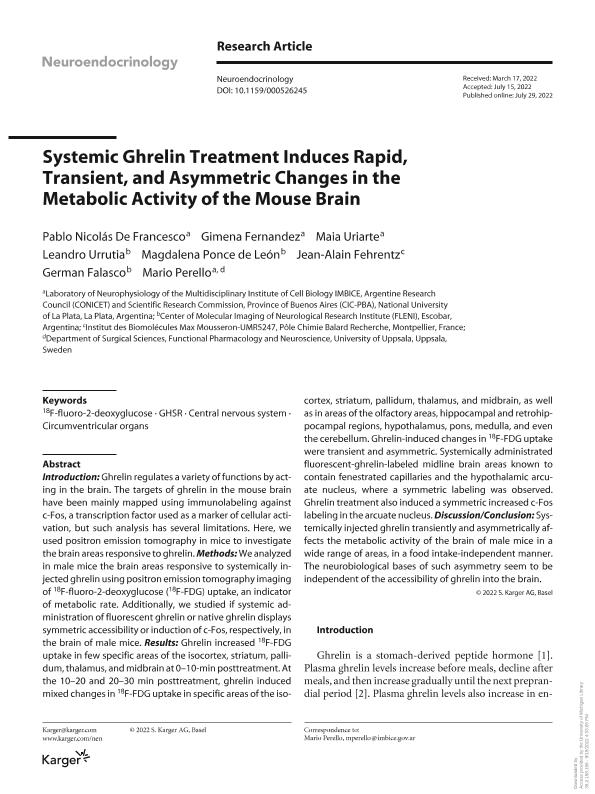Artículo
Systemic ghrelin treatment induces rapid, transient and asymmetric changes in the metabolic activity of the mouse brain
de Francesco, Pablo Nicolás ; Fernandez, Gimena
; Fernandez, Gimena ; Uriarte Donati, Maia
; Uriarte Donati, Maia ; Urrutia, Leandro; Ponce de León, Magdalena; Fehrentz, Jean Alain; Falasco, German; Perello, Mario
; Urrutia, Leandro; Ponce de León, Magdalena; Fehrentz, Jean Alain; Falasco, German; Perello, Mario
 ; Fernandez, Gimena
; Fernandez, Gimena ; Uriarte Donati, Maia
; Uriarte Donati, Maia ; Urrutia, Leandro; Ponce de León, Magdalena; Fehrentz, Jean Alain; Falasco, German; Perello, Mario
; Urrutia, Leandro; Ponce de León, Magdalena; Fehrentz, Jean Alain; Falasco, German; Perello, Mario
Fecha de publicación:
07/2022
Editorial:
Karger
Revista:
Neuroendocrinology
ISSN:
0028-3835
Idioma:
Inglés
Tipo de recurso:
Artículo publicado
Clasificación temática:
Resumen
Introduction: Ghrelin regulates a variety of functions by acting in the brain. The targets of ghrelin in the mouse brain have been mainly mapped using immunolabeling against c-Fos, a transcription factor used as a marker of cellular activation, but such analysis has several limitations. Here, we used positron emission tomography in mice to investigate the brain areas responsive to ghrelin. Methods: We analyzed in male mice the brain areas responsive to systemically injected ghrelin using positron emission tomography imaging of 18F-fluoro-2-deoxyglucose (18F-FDG) uptake, an indicator of metabolic rate. Additionally, we studied if systemic administration of fluorescent ghrelin or native ghrelin displays symmetric accessibility or induction of c-Fos, respectively, in the brain of male mice. Results: Ghrelin increased 18F-FDG uptake in few specific areas of the isocortex, striatum, pallidum, thalamus, and midbrain at 0-10-min posttreatment. At the 10-20 and 20-30 min posttreatment, ghrelin induced mixed changes in 18F-FDG uptake in specific areas of the isocortex, striatum, pallidum, thalamus, and midbrain, as well as in areas of the olfactory areas, hippocampal and retrohippocampal regions, hypothalamus, pons, medulla, and even the cerebellum. Ghrelin-induced changes in 18F-FDG uptake were transient and asymmetric. Systemically administrated fluorescent-ghrelin-labeled midline brain areas known to contain fenestrated capillaries and the hypothalamic arcuate nucleus, where a symmetric labeling was observed. Ghrelin treatment also induced a symmetric increased c-Fos labeling in the arcuate nucleus. Discussion/Conclusion: Systemically injected ghrelin transiently and asymmetrically affects the metabolic activity of the brain of male mice in a wide range of areas, in a food intake-independent manner. The neurobiological bases of such asymmetry seem to be independent of the accessibility of ghrelin into the brain.
Archivos asociados
Licencia
Identificadores
Colecciones
Articulos(IMBICE)
Articulos de INST.MULTIDISCIPL.DE BIOLOGIA CELULAR (I)
Articulos de INST.MULTIDISCIPL.DE BIOLOGIA CELULAR (I)
Citación
de Francesco, Pablo Nicolás; Fernandez, Gimena; Uriarte Donati, Maia; Urrutia, Leandro; Ponce de León, Magdalena; et al.; Systemic ghrelin treatment induces rapid, transient and asymmetric changes in the metabolic activity of the mouse brain; Karger; Neuroendocrinology; 113; 1; 7-2022; 64-79
Compartir
Altmétricas



